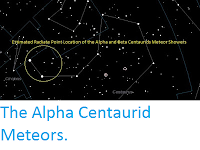The Lyrid Meteors are typically visible between 16 and 25 April each year, and will be at peak visibility on the night of Saturday 22 April in 2017. This is only a few days before the New Moon on Wednesday 26 April, so viewing this year should be good. At its peak the Lyrid Meteor shower typically produces about 20 meteors per hour, though higher rates have been recorded.
Sky map showing the radiant point for the Lyrid Meteors (i.e. the point from which the meteors appear to radiate). Sky & Telescope.
The Lyrid Meteors are comprised of debris from the comet C/1861 G1
Thatcher (named after the astronomer A. E. Thatcher, not the
politician). This is a long-period comet that spends most of its time in
the Oort Cloud, only visiting the inner Solar System once every 415
years, the last occasion being in 1861. When the comet visits the inner
Solar System it is heated by the Sun, melting the ices that make up its
surface and releasing a trail of dust, which continues to follow the
path of the comet. The Earth passes through this trail in April each
year, creating a light show as the dust particles burn in the upper
atmosphere which appears to radiate from the star Vega in the constellation of Lyra.
See also...
Follow Sciency Thoughts on Facebook.







